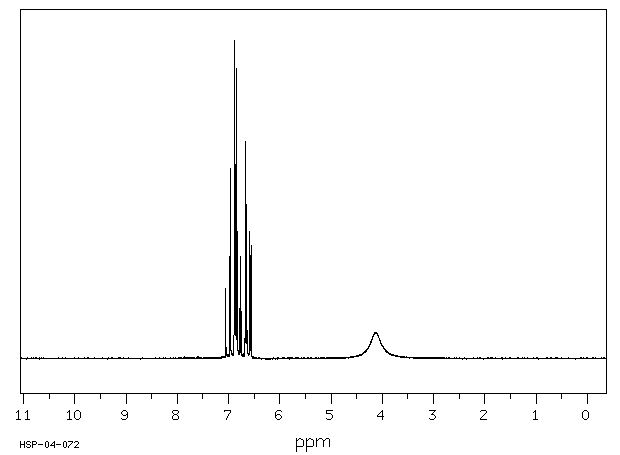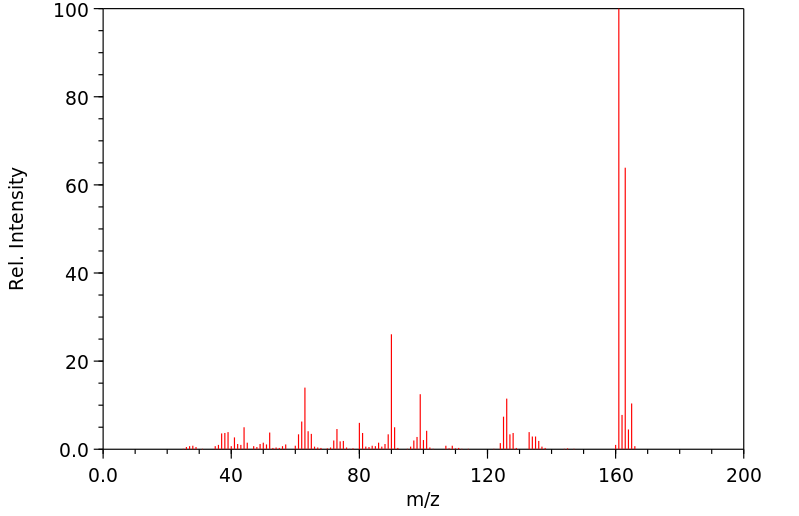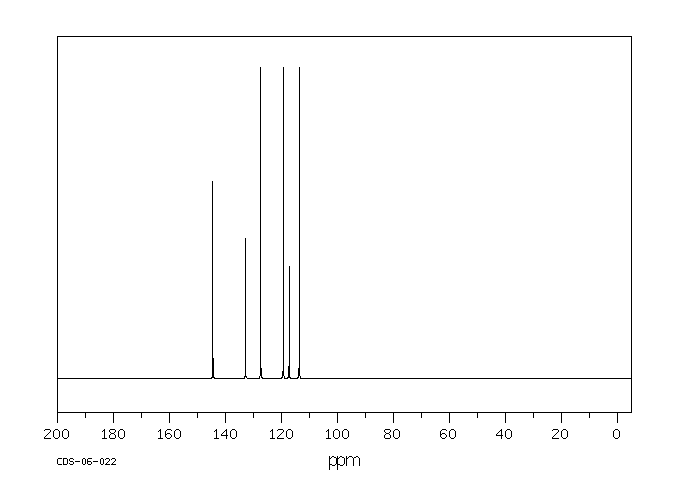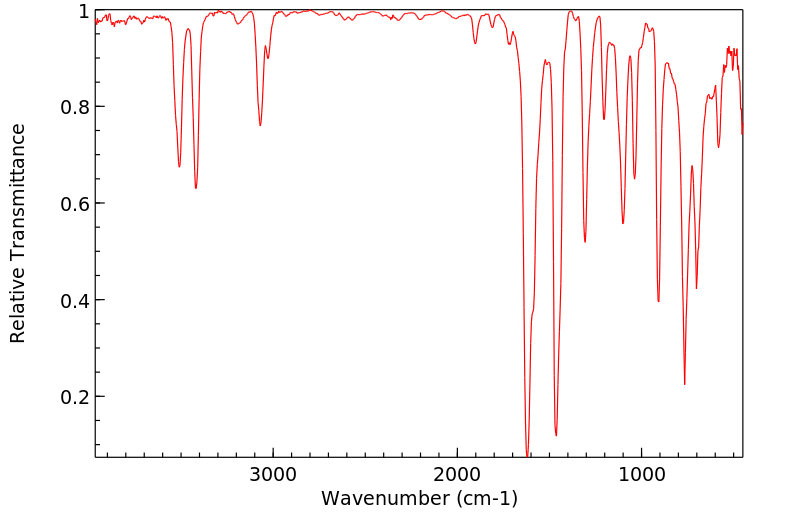2,3-二氯苯胺 | 608-27-5
-
物化性质
-
计算性质
-
ADMET
-
安全信息
-
SDS
-
制备方法与用途
-
上下游信息
-
文献信息
-
表征谱图
-
同类化合物
-
相关功能分类
-
相关结构分类
物化性质
-
熔点:20-25 °C (lit.)
-
沸点:252 °C (lit.)
-
密度:1.37 g/mL at 20 °C (lit.)
-
闪点:>230 °F
-
溶解度:氯仿(微溶)、乙酸乙酯(微溶)、甲醇(微溶)
-
物理描述:Dichloroanilines appears as an amber to brown crystalline solid. Shipped as a solid or in a liquid carrier. Insoluble in water. It is toxic by skin absorption and by inhalation. Produces toxic oxides of nitrogen during combustion. Used in the manufacture of dyes and pesticides.
-
颜色/状态:NEEDLES FROM PETROLEUM ETHER
-
蒸汽密度:Relative vapor density (air = 1): 5.6
-
蒸汽压力:Vapor pressure, Pa at 25 °C:
-
分解:When heated to decomposition it emits highly toxic fumes of /hydrogen chloride/ and nitrogen oxides. /2,5-Dichloroaniline/
-
折光率:Index of refraction: 1.5969 at 20 °C
-
保留指数:1312.7;1301;1302;1306;1306
计算性质
-
辛醇/水分配系数(LogP):2.9
-
重原子数:9
-
可旋转键数:0
-
环数:1.0
-
sp3杂化的碳原子比例:0.0
-
拓扑面积:26
-
氢给体数:1
-
氢受体数:1
ADMET
安全信息
-
TSCA:Yes
-
危险等级:6.1
-
危险品标志:T,N
-
安全说明:S28,S28A,S36/37,S45,S60,S61
-
危险类别码:R23/24/25,R50/53,R33
-
WGK Germany:3
-
海关编码:2921420090
-
危险品运输编号:UN 3442 6.1/PG 2
-
危险类别:6.1
-
RTECS号:CX9862625
-
包装等级:II
SDS
制备方法与用途
2,3-二氯苯胺是重要的有机原料中间体,在农药、医药、染料和感光材料等精细化工行业中有着广泛的应用。其合成路线主要以2,3-二氯硝基苯为原料,有研究报道使用碳化钨作为催化剂进行加氢还原制备,但该方法存在两个主要问题:一是加氢过程对设备材质要求较高,并且存在一定安全隐患;二是由于2,3-二氯硝基苯的制备和提纯较为复杂,导致原料成本偏高。
制备方法以1,2,3-三氯苯和氨水为原料,在金属铜离子作为催化剂、季铵盐类和聚醚类作为相转移催化剂的作用下,于特定温度和压力条件下进行氨解反应,可以一步制得2,3-二氯苯胺/2,6-二氯苯胺。相比于传统的合成工艺,该方法具有显著优点:利用了在二氯苯生产过程中产生的副产物1,2,3-三氯苯作为原料,通过一步氨解直接获得目标产物。
化学性质2,3-二氯苯胺是一种水白色至浅黄色的液体或结晶。其熔点为24℃,沸点为252℃。
用途主要用作医药和农药中间体。
上下游信息
-
上游原料
中文名称 英文名称 CAS号 化学式 分子量 2,5-二氯苯胺 2,5 dichloroaniline 95-82-9 C6H5Cl2N 162.018 3,4,5-三氯苯胺 3,4,5-trichloroaniline 634-91-3 C6H4Cl3N 196.463 —— 1-azido-2,3-dichlorobenzene 62416-02-8 C6H3Cl2N3 188.016 3-氯苯基羟胺 N-(3-chlorophenyl)hydroxylamine 10468-17-4 C6H6ClNO 143.573 -
下游产品
中文名称 英文名称 CAS号 化学式 分子量 —— N-(2,3-dichlorophenyl)hydroxylamine 43192-06-9 C6H5Cl2NO 178.018 N-(2,3-二氯苯基)-N-甲胺 2,3-dichloro-N-methylaniline 42265-79-2 C7H7Cl2N 176.045 (2,3-二氯苯基)肼 2,3-dichloro-phenylhydrazine 13147-14-3 C6H6Cl2N2 177.033 3-氯苯胺 3-chloro-aniline 108-42-9 C6H6ClN 127.573 —— 1-azido-2,3-dichlorobenzene 62416-02-8 C6H3Cl2N3 188.016 —— 1,2-Dichloro-3-[(oxo-lambda~4~-sulfanylidene)amino]benzene 63170-21-8 C6H3Cl2NOS 208.068 —— 2,3-dichloroformanilide 6327-47-5 C7H5Cl2NO 190.029 (2,3-二氯苯基)-乙胺 2,3-dichloro-N-ethylaniline 49850-15-9 C8H9Cl2N 190.072 2,3-二氯苯基异氰酸酯 1,2-dichloro-3-isocyanatobenzene 41195-90-8 C7H3Cl2NO 188.013 —— 2,3-dichloro-4-iodoaniline 329926-85-4 C6H4Cl2IN 287.915 2,3-二氯苯基硫代异氰酸酯 2,3-dichloro-1-isothiocyanatobenzene 6590-97-2 C7H3Cl2NS 204.08 —— 2,3-Dichlor-4-mercapto-anilin 15178-56-0 C6H5Cl2NS 194.084 4-溴-2,3-二氯苯胺 4-bromo-2,3-dichlorophenylamine 56978-48-4 C6H4BrCl2N 240.914 —— 2,3-dichloro-N-phenylaniline 105837-54-5 C12H9Cl2N 238.116 —— N1-(2,3-dichlorophenyl)ethane-1,2-diamine 40779-32-6 C8H10Cl2N2 205.087 —— 2,2',3,3'-Tetrachlor-azobenzol 20809-83-0 C12H6Cl4N2 320.005 2-(2,3-二氯苯胺基)乙醇 2-<(2,3-dichlorophenyl)amino>ethanol 87762-19-4 C8H9Cl2NO 206.072 —— N-allyl-2,3-dichloroaniline 603958-61-8 C9H9Cl2N 202.083 —— N-(2,3-dichlorophenyl)-N'-methylmethanimidamide 76662-31-2 C8H8Cl2N2 203.071 - 1
- 2
反应信息
-
作为反应物:参考文献:名称:无配体铜(0)催化的C−S乌尔曼型交叉偶联反应:5,4-二取代的2,4-二氢-3H-1,2,4-三唑-3-硫酮的S-芳基化摘要:在无配体 Cu(0) 催化的 Ullmann 型反应条件下研究了 5,4-二取代 2,4-二氢-3H-1,2,4-三唑-3-硫酮的芳基化反应,结果表明该反应以化学选择性进行并形成S-芳基化产物。在一些情况下,当芳基化剂中存在吸电子基团时,反应可以在没有催化剂的情况下进行。DOI:10.1002/ejoc.202400199
-
作为产物:参考文献:名称:Hydrogenation of halogen-substituted aromatic nitro compounds摘要:这项发明涉及卤素取代芳香亚硝基化合物的氢化,特别提供了一种新型催化剂用于此类过程。更详细地说,用于卤素取代芳香亚硝基化合物的氢化而基本上不伴随脱卤反应的催化剂包括铂、钯、铑、铱、钌和锇等金属中的一个或多个,这些金属负载于或浸渍到由磷酸活化的碳或其盐组成的载体材料中。公开号:US04375550A1
文献信息
-
CHROMENONE DERIVATIVES申请人:BARLAAM Bernard Christophe公开号:US20110098271A1公开(公告)日:2011-04-28The invention concerns chromenone derivatives of Formula I or a pharmaceutically-acceptable salts thereof, wherein each of R 1 , R 2 , R 3 , R 4 , R 5 , R 6 , R 7 , R 8 , n and R 9 has any of the meanings defined hereinbefore in the description; processes for their preparation, pharmaceutical compositions containing them and their use in the manufacture of a medicament for use in the treatment of cell proliferative disorders.
-
Method of treatment申请人:William H. Rorer, Inc.公开号:US04200648A1公开(公告)日:1980-04-29This invention describes a method of treating inflammation in warm-blooded animals by topically administering an effective amount of a benzylideneaniline derivative, and the compositions therefore.
-
Synthesis and biological activity of 2-[2-(7-chloroquinolin-4-ylthio)-4-methylthiazol-5-yl]-<i>N</i>-phenylacetamide derivatives as antimalarial and cytotoxic agents作者:Hegira Rámirez、Juan R Rodrigues、Michael R Mijares、Juan B De Sanctis、Jaime E CharrisDOI:10.1177/1747519819899073日期:2020.5A novel series of 2-[2-(7-chloroquinolin-4-ylthio)-4-methylthiazol-5-yl]-N-phenylacetamide derivatives is synthesized via substitution with 2-mercapto-4-methyl-5-thiazoleacetic acid at position 4 of 4,7-dichloroquinoline to obtain an intermediate acetic acid derivative. The chemical behavior of these reactants was investigated using different reaction conditions to optimize the nucleophilic substitution
-
Microwave-Assisted Rapid and efficient Reduction of Aromatic Nitro Compounds to Amines with Propan-2-ol over Nanosized Perovskite-type SmFeO<sub>3</sub> powder as a New Recyclable Heterogeneous Catalyst作者:Saeid Farhadi、Firouzeh Siadatnasab、Maryam KazemDOI:10.3184/174751911x12964930076647日期:2011.2
Nanosized perovskite-type SmFeO3 powder, prepared through the thermal decomposition of Sm[Fe(CN)6].4H2O with an average particle diameter of 28 nm and a specific surface area of 42 m2 g−1, was used as a recyclable heterogeneous catalyst for the efficient and selective reduction of aromatic nitro compounds into the corresponding amines by using propan-2-ol as a hydrogen donor (reducing agent) and KOH as a promoter under microwave irradiation. This highly regio- and chemoselective catalytic method is fast, clean, inexpensive, high yielding and also compatible with the substrates containing easily reducible functional groups. In addition, the nanosized SmFeO3 catalyst can be reused without loss of activity.
-
NOVEL COMPOUNDS AS CANNABINOID RECEPTOR LIGANDS AND USES THEREOF申请人:Florjancic S. Alan公开号:US20080058335A1公开(公告)日:2008-03-06The present invention relates to compounds of formula (I), or pharmaceutical salts, prodrugs, salts of prodrugs, or combinations thereof, wherein R 1 , R 2 , R 3 , and L 1 are defined in the specfication, compositions comprising such compounds, and methods of treating conditions and disorders using such compounds and compositions. The present invention also relates to compounds of formula (II), or pharmaceutical salts, prodrugs, salts of prodrugs, or combinations thereof, wherein R 1a , R 2a and (Rx)n are as defined in the specification, compositions comprising such compounds, and methods of treating conditions and disorders using such compounds and compositions.本发明涉及式(I)的化合物,或药用盐、前药、前药的盐或其组合物, 其中R 1 ,R 2 ,R 3 和L 1 在规范中定义,包含这种化合物的组合物,以及使用这种化合物和组合物治疗疾病和疾病的方法。本发明还涉及式(II)的化合物,或药用盐、前药、前药的盐或其组合物, 其中R 1a ,R 2a 和(Rx)n如规范中定义,包含这种化合物的组合物,以及使用这种化合物和组合物治疗疾病和疾病的方法。
表征谱图
-
氢谱1HNMR
-
质谱MS
-
碳谱13CNMR
-
红外IR
-
拉曼Raman
-
峰位数据
-
峰位匹配
-
表征信息










